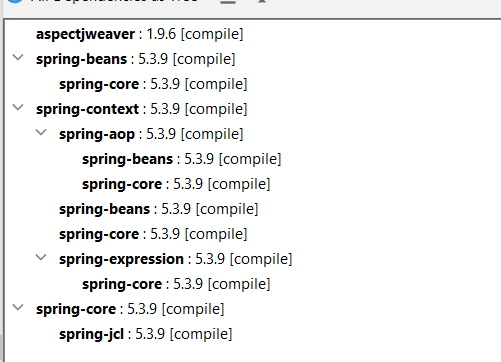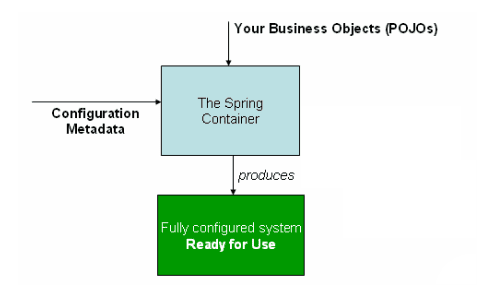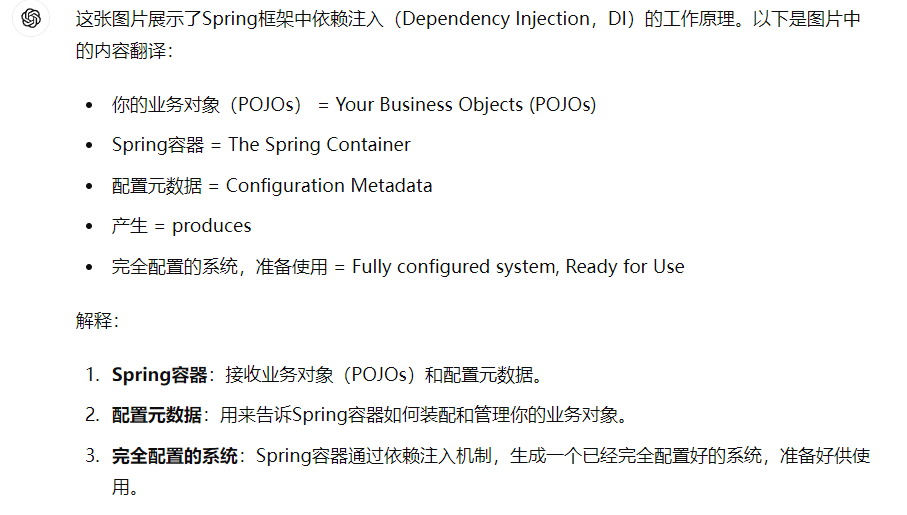spring 框架常用场景:

ORM -> DAO(Data access object) -> POJO -> 被 IOC 容器管理 -> service - 业务逻辑层 -> controller - 业务展示层
Hello World
设计一个查询用户的案例的两个需求,来看spring框架做了什么简化的工作
- 查询用户数据 - 来看DAO +POJO -> Service的初始化和装载
- 给所有Service的查询方法记录日志
- 创建一个 Maven的Java项目
- 引入Spring框架的POM依赖,以及查看这些依赖之间的关系
<?xml version="1.0" encoding="UTF-8"?>
<project xmlns="http://maven.apache.org/POM/4.0.0"
xmlns:xsi="http://www.w3.org/2001/XMLSchema-instance"
xsi:schemaLocation="http://maven.apache.org/POM/4.0.0 http://maven.apache.org/xsd/maven-4.0.0.xsd">
<modelVersion>4.0.0</modelVersion>
<groupId>tech.pdai</groupId>
<artifactId>001-spring-framework-demo-helloworld-xml</artifactId>
<version>1.0-SNAPSHOT</version>
<properties>
<maven.compiler.source>8</maven.compiler.source>
<maven.compiler.target>8</maven.compiler.target>
<spring.version>5.3.9</spring.version>
<aspectjweaver.version>1.9.6</aspectjweaver.version>
</properties>
<dependencies>
<dependency>
<groupId>org.springframework</groupId>
<artifactId>spring-context</artifactId>
<version>${spring.version}</version>
</dependency>
<dependency>
<groupId>org.springframework</groupId>
<artifactId>spring-core</artifactId>
<version>${spring.version}</version>
</dependency>
<dependency>
<groupId>org.springframework</groupId>
<artifactId>spring-beans</artifactId>
<version>${spring.version}</version>
</dependency>
<dependency>
<groupId>org.aspectj</groupId>
<artifactId>aspectjweaver</artifactId>
<version>${aspectjweaver.version}</version>
</dependency>
</dependencies>
</project>

- POJO - User
package tech.pdai.springframework.entity;
/**
* @author pdai
*/
public class User {
/**
* user's name.
*/
private String name;
/**
* user's age.
*/
private int age;
/**
* init.
*
* @param name name
* @param age age
*/
public User(String name, int age) {
this.name = name;
this.age = age;
}
public String getName() {
return name;
}
public void setName(String name) {
this.name = name;
}
public int getAge() {
return age;
}
public void setAge(int age) {
this.age = age;
}
}
- DAO 获取 POJO,UserDaoServiceImpl(mock数据)
package tech.pdai.springframework.dao;
import java.util.Collections;
import java.util.List;
import tech.pdai.springframework.entity.User;
/**
* @author pdai
*/
public class UserDaoImpl {
/**
* init.
*/
public UserDaoImpl() {
}
/**
* mocked to find user list.
*
* @return user list
*/
public List<User> findUserList() {
return Collections.singletonList(new User("pdai", 18));
}
}
并增加daos.xml
<?xml version="1.0" encoding="UTF-8"?>
<beans xmlns="http://www.springframework.org/schema/beans"
xmlns:xsi="http://www.w3.org/2001/XMLSchema-instance"
xsi:schemaLocation="http://www.springframework.org/schema/beans
http://www.springframework.org/schema/beans/spring-beans.xsd">
<bean id="userDao" class="tech.pdai.springframework.dao.UserDaoImpl">
<!-- additional collaborators and configuration for this bean go here -->
</bean>
<!-- more bean definitions for data access objects go here -->
</beans>
- 业务层 UserServiceImpl(调用DAO层)
package tech.pdai.springframework.service;
import java.util.List;
import tech.pdai.springframework.dao.UserDaoImpl;
import tech.pdai.springframework.entity.User;
/**
* @author pdai
*/
public class UserServiceImpl {
/**
* user dao impl.
*/
private UserDaoImpl userDao;
/**
* init.
*/
public UserServiceImpl() {
}
/**
* find user list.
*
* @return user list
*/
public List<User> findUserList() {
return this.userDao.findUserList();
}
/**
* set dao.
*
* @param userDao user dao
*/
public void setUserDao(UserDaoImpl userDao) {
this.userDao = userDao;
}
}
并增加services.xml
<?xml version="1.0" encoding="UTF-8"?>
<beans xmlns="http://www.springframework.org/schema/beans"
xmlns:xsi="http://www.w3.org/2001/XMLSchema-instance"
xsi:schemaLocation="http://www.springframework.org/schema/beans
http://www.springframework.org/schema/beans/spring-beans.xsd">
<!-- services -->
<bean id="userService" class="tech.pdai.springframework.service.UserServiceImpl">
<property name="userDao" ref="userDao"/>
<!-- additional collaborators and configuration for this bean go here -->
</bean>
<!-- more bean definitions for services go here -->
</beans>
- 拦截所有service中的方法,并输出记录
package tech.pdai.springframework.aspect;
import java.lang.reflect.Method;
import org.aspectj.lang.ProceedingJoinPoint;
import org.aspectj.lang.annotation.Around;
import org.aspectj.lang.annotation.Aspect;
import org.aspectj.lang.reflect.MethodSignature;
import org.springframework.context.annotation.EnableAspectJAutoProxy;
/**
* @author pdai
*/
@Aspect
public class LogAspect {
/**
* aspect for every methods under service package.
*/
@Around("execution(* tech.pdai.springframework.service.*.*(..))")
public Object businessService(ProceedingJoinPoint pjp) throws Throwable {
// get attribute through annotation
Method method = ((MethodSignature) pjp.getSignature()).getMethod();
System.out.println("execute method: " + method.getName());
// continue to process
return pjp.proceed();
}
}
并且增加aspects.xml
<?xml version="1.0" encoding="UTF-8"?>
<beans xmlns="http://www.springframework.org/schema/beans"
xmlns:xsi="http://www.w3.org/2001/XMLSchema-instance"
xmlns:aop="http://www.springframework.org/schema/aop"
xmlns:context="http://www.springframework.org/schema/context"
xsi:schemaLocation="http://www.springframework.org/schema/beans
http://www.springframework.org/schema/beans/spring-beans.xsd
http://www.springframework.org/schema/aop
http://www.springframework.org/schema/aop/spring-aop.xsd
http://www.springframework.org/schema/context
http://www.springframework.org/schema/context/spring-context.xsd
">
<context:component-scan base-package="tech.pdai.springframework" />
<aop:aspectj-autoproxy/>
<bean id="logAspect" class="tech.pdai.springframework.aspect.LogAspect">
<!-- configure properties of aspect here as normal -->
</bean>
<!-- more bean definitions for data access objects go here -->
</beans>
- 组装App
package tech.pdai.springframework;
import java.util.List;
import org.springframework.context.ApplicationContext;
import org.springframework.context.support.ClassPathXmlApplicationContext;
import tech.pdai.springframework.entity.User;
import tech.pdai.springframework.service.UserServiceImpl;
/**
* @author pdai
*/
public class App {
/**
* main interfaces.
*
* @param args args
*/
public static void main(String[] args) {
// create and configure beans
ApplicationContext context =
new ClassPathXmlApplicationContext("aspects.xml", "daos.xml", "services.xml");
// retrieve configured instance
UserServiceImpl service = context.getBean("userService", UserServiceImpl.class);
// use configured instance
List<User> userList = service.findUserList();
// print info from beans
userList.forEach(a -> System.out.println(a.getName() + "," + a.getAge()));
}
}
- 整体结构和运行app

以上例子体现了 Spring 的核心要点:
控制反转 - IOC
查询用户(service 通过调用 dao 查询 pojo),本质上如何创建 User/Dao/Service
- 如果没有spring框架,我们需要自己创建User/Dao/Service等,比如:
UserDaoImpl userDao = new UserDaoImpl();
UserServiceImpl userService = new UserServiceImpl();
userService.setUserDao(userDao);
List<User> userList = userService.findUserList();
- 有了spring框架,可以将原有的Bean的创建工作转给框架,需要用的时候从 Bean 容器中获取即可,这样就简化了开发工作。
Bean 的创建和使用分离了
// create and configure beans
ApplicattionContext context = new ClassPathXmlApplicationContext("aspects.xml", "daos.xml", "services.xml");
// retrieve connfigured instance
UserServiceImpl service = context.getBean("userService", UserServiceImpl.class);
// use configured instance
List<User> userList = service.findUserList();


- Spring框架管理这些Bean的创建工作,即由用户管理Bean转变为框架管理Bean,这个就叫控制反转 - Inversion of Control (IoC)
- Spring 框架托管创建的Bean放在哪里呢? 这便是IoC Container;
- Spring 框架为了更好让用户配置Bean,必然会引入不同方式来配置Bean? 这便是xml配置,Java配置,注解配置等支持
- Spring 框架既然接管了Bean的生成,必然需要管理整个Bean的生命周期等;
- 应用程序代码从Ioc Container中获取依赖的Bean,注入到应用程序中,这个过程叫 依赖注入(Dependency Injection,DI) ; 所以说控制反转是通过依赖注入实现的,其实它们是同一个概念的不同角度描述。通俗来说就是IoC是设计思想,DI是实现方式
- 在依赖注入时,有哪些方式呢?这就是构造器方式,@Autowired, @Resource, @Qualifier… 同时Bean之间存在依赖(可能存在先后顺序问题,以及循环依赖问题等)






















 718
718

 被折叠的 条评论
为什么被折叠?
被折叠的 条评论
为什么被折叠?








